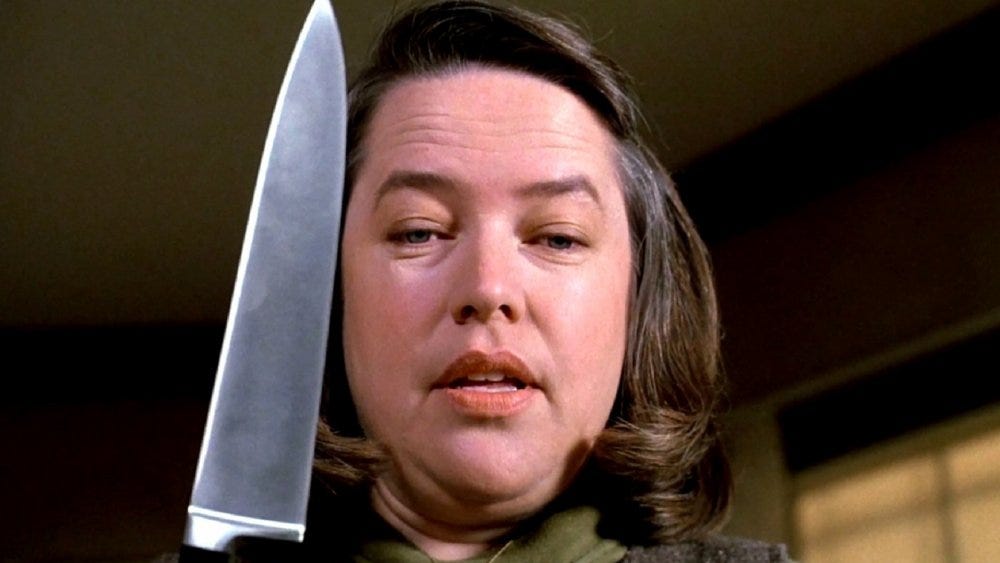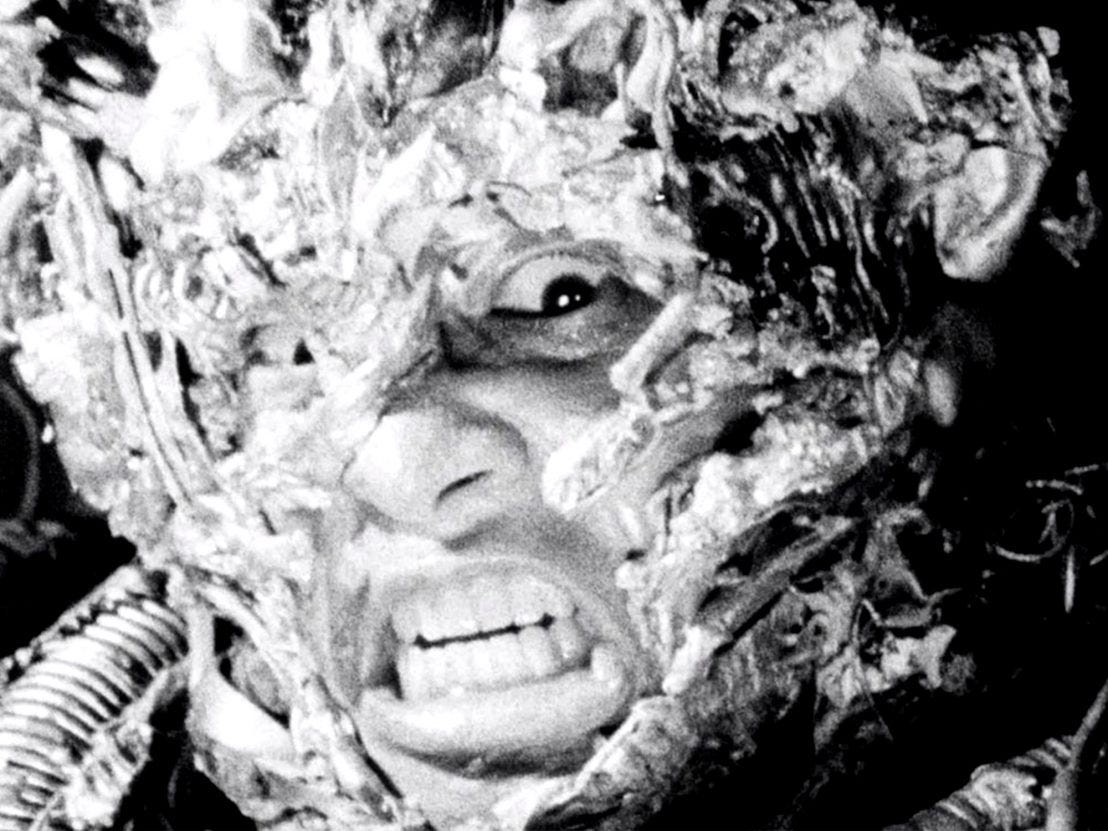SHOCKTOBER: Misery (1990)
Revisiting a classic Stephen King adaptation. Plus: Tetsuo: The Iron Man (1989) and past SHOCKTOBER lineups.
It’s spooky season. Every year, my wife and I spend October exploring the cinematic eerie, macabre, and downright frightening in an annual tradition we call SHOCKTOBER. I’ll be posting weekly write-ups for this year’s selections here at Discontent Dispatch.
Misery (1990)
You’re bedridden, kept in a small room in an unfamiliar house. The bones in your legs are shattered, keeping you both immobilized and in constant pain. You depend on your nurse for everything – medical attention (including your pain pills: a necessity, given your physical state), food, even assistance using the bathroom. And sure, she’s happy to help. Insists on helping, in fact. But she expects a few things in return. Not just gratitude – you’re happy to offer that, at least at first – but something closer to devotion. A little positive attention. A few kind words now and then.
One more thing – she wants you to write a novel. (Have I mentioned you’re a writer?) The grand finale of the series that made your name. “Nothing less,” as she herself puts it, “than your masterpiece.” Just for her.
After all, she saved your life. You are her favorite writer. And she’s your number one fan.
This is the situation in which novelist Paul Sheldon (James Caan), author of a series of bestselling bodice-rippers, finds himself. After venturing out into a blizzard and crashing his car, he awakens in the care of Annie Wilkes (Kathy Bates), who adores both Paul and his literary heroine, Misery Chastain. But while her intervention seems at first like a stroke of luck, it soon becomes clear how unlucky Paul really is.
I insisted on Misery to kick off SHOCKTOBER ‘22. I’ve been getting back into Stephen King, and Misery was always the story that most captured my imagination (aside from The Shining, that is). After rereading the novel this summer, I wanted to see how the film held up. If nothing else, it would at least be good for a few scares, especially since being held hostage by a psychotic nurse is one of my greatest fears. (Don’t ask.)
Kathy Bates’ performance is what people remember, and with good reason. The film’s greatest asset is its cast – in addition to Bates and Caan, Misery boasts standout supporting performances by Lauren Bacall (!) and Richard Farnsworth – but Bates is unquestionably the highlight. It’s not just that she’s terrifying in the role, though she is. Bates’ performance humanizes Annie, transforming the character from the hulking, monstrous presence she is in King’s novel into a fully-fleshed, believable human being – making her that much more terrifying. If there’s one way the film improves on its source material, this is it.
Overall, it’s a solid movie. Rob Reiner’s direction is serviceable, as is William Goldman’s script. Key elements of the story are colorfully, imaginatively realized: Annie’s house, complete with its little Paul Sheldon shrine (featuring all the Misery novels arranged around an 8x10 of his author photo), conveys nearly as much about her character as Kathy Bates’ performance. Major set pieces – including the hobbling scene and the finale – have lost none of their impact. The whole thing pops.
Since I revisited the novel so recently, I couldn’t help but catalog the differences between Misery and its source material. The film is a taut psychological thriller; the novel is a lurid horror story. Many of the novel’s more gruesome details are absent from the film – mostly to its benefit, unless you’re eager to see Annie crush rats in her hands or saw off Paul’s thumb with a carving knife. That said, I can’t help but feel that other changes – often fairly significant – reduce the impact of the original story.
For example: some dimensions of Annie and Paul’s relationship are lost in the transition from page to screen. Both versions of Misery work to portray Annie Wilkes as the ultimate obsessed fan, with chilling (and prescient) results. She’s constantly transforming from caretaker to taskmaster to tyrant, always embodying the deep spiritual and quasi-romantic qualities of fandom – along with the entitlement and rage.
The movie, however, really accentuates Annie's romantic interest in Paul. This is most obvious in the dinner scene, which does not appear in King’s novel. After beginning work on Misery’s Return, the novel she’s forced on him, Paul asks Annie to dinner to “celebrate” – a pretext, as he really intends to poison her. She, of course, enthusiastically accepts his invitation. At the dinner, Annie radiates bashful, shy-girl energy, to the point where she’s less “psychotic fan who may kill you” than “weird girl who is really into you.” This aspect of Annie’s personality is present in King’s version – her professions of love are pulled straight from the novel – but the film’s overwhelming interest in the “romantic” quality of the fan-artist relationship partly blunts the full scope and force of her derangement. It makes Annie pitiable when she should be fearsome.
The story’s structure is changed, as well. Stephen King’s Misery never strays far from Paul Sheldon’s consciousness. As a result, Paul’s experience becomes the reader’s experience; every harrowing encounter with Annie’s psychosis is laid out in excruciating detail. It’s an extremely effective technique for inspiring terror.
The film, by contrast, leaves Annie’s house early and often, following Farnsworth’s local Sheriff, Buster, as he investigates Paul’s disappearance. As a result, the film loses a lot of the novel’s claustrophobia. We don’t feel confined along with Paul because we aren’t. We don’t have to wonder whether anyone will find him, because we watch Buster’s investigation as it unfolds. To me, this largely seems like a product of the filmmakers’ aversion to risk. A more adventurous director might have attempted to keep the novel’s structure intact, but Rob Reiner opts for the safe road.1
Maybe these changes were made to conform to the expectations of the moviegoing audience. But I suspect they both sprung up to fill a vacuum left when the filmmakers abandoned one of the novel’s core themes.
Stephen King’s Misery is very much a novel about writing. Paul’s daily struggle to complete Misery’s Return forms one of its major dramatic threads. He progresses from resistance to the idea of reviving Misery Chastain (he’d killed her off in the series’ previous installment, enraging Annie), to begrudging acceptance, to active investment into the project, to, ultimately, publication. In the film, much of this arc disappears, mostly relegated to a montage. Misery’s Return – the actual writing of it – transforms from a major story element to window dressing. The attachment Paul comes to feel for the project vanishes, too. In the novel’s finale, he destroys a decoy manuscript, salvaging the real one for later publication. In the film, he destroys it for real.
Paul’s lack of investment in Misery’s Return may be why the film’s coda rings a bit hollow for me. We see Paul, 18 months after leaving Annie’s, having lunch with his agent (Bacall) in New York. He’s still dinged up, but he has a new novel coming out – a Serious Novel – and it’s getting rave reviews. No more Misery. He’s done with all that.
The conversation turns to Annie Wilkes. He says he’ll “never fully get over” what happened – and a vision he has of Annie suggests that yes, this is true – but something about his protest rings a little hollow. He was able to sacrifice Misery’s Return, after all. If he’s done with Misery Chastain, really done, maybe he can be done with Annie Wilkes, too.
The novel’s ending suggests the exact opposite. By saving and publishing Misery’s Return, Paul reveals how much he can’t let go of Misery – or Annie, since without Annie there would be no Misery’s Return. She and Paul are bound together on every page of that novel; she’s present in every word. In his novel – and his life – he’s tethered to Annie forever.
Now that’s chilling.
Tetsuo: The Iron Man (1989)
I’d never heard of this movie before the Criterion Channel added it to their ‘80s Horror collection. At first, I thought it might be an obscure Akira adaptation; after finding myself intrigued by the IMDb synopsis (“A businessman accidentally kills The Metal Fetishist, who gets his revenge by slowly turning the man into a grotesque hybrid of flesh and rusty metal”), I added it to my watchlist.
It’s safe to say I have never seen another movie quite like this. The in-your-face editing and thunderous industrial soundtrack hammers at you for 67 brutal minutes. The transformation of the businessman (Tomorô Taguchi) into a horrific man-machine hybrid is a parade of surreal, often shocking, visuals, recalling both Cronenberg and Akira’s gruesome finale (I guess I wasn’t that far off). If you missed the connection between iron and sex, you’ll get it when the businessman’s penis becomes a massive rotating drill. This movie does not do subtlety.
Tetsuo is certainly not for everyone. It’s bizarre, extreme, and inscrutable. But it is worth a watch, if only for the experience of it.
Bonus: Past SHOCKTOBER Lineups
SHOCKTOBER was never meant to be public, per se. It was just a way for my wife and I to watch some great movies together. So far, it’s been a wild success – we look forward to it every year. Check out our past lineups and you’ll see why.
2020
Dead Ringers (1988)
Shutter Island (2010)
The Wicker Man (1973)
The Witch (2016)
2021
American Psycho (2000)
Beetlejuice (1991)
A Nightmare on Elm Street (1984)
Thanks for reading! See you next week!
This structural change also arguably creates a plot hole. When Buster visits the General Store to find out whether Annie Wilkes is a Paul Sheldon fan, Pete, the store owner, not only confirms that she is, but tells Buster that she recently started purchasing reams of typewriter paper. Maybe this guy is a rube, but it’s hard to believe that Silver Creek, Colorado’s #1 Paul Sheldon fan could suddenly purchase writing paper weeks after his disappearance without anyone batting an eye. In small towns, people talk.







